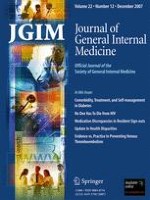Published in:

01-12-2007 | Populations at Risk
AMPATH: Living Proof that No One Has to Die from HIV
Authors:
Thomas S. Inui, ScM, MD, Winston M. Nyandiko, MD, Sylvester N. Kimaiyo, MD, Richard M. Frankel, PhD, Tadeo Muriuki, BA, Joseph J. Mamlin, MD, Robert M. Einterz, MD, John E. Sidle, MD, MS
Published in:
Journal of General Internal Medicine
|
Issue 12/2007
Login to get access
Abstract
Background and Objective
The HIV/AIDS epidemic in sub-Saharan Africa is decimating populations, deteriorating economies, deepening poverty, and destabilizing traditional social orders. The advent of the U.S. President’s Emergency Plan for AIDS Relief (PEPFAR) made significant supplemental resources available to sub-Saharan national programs for the prevention and treatment of HIV/AIDS, but few programs have demonstrated the capacity to use these resources to increase rapidly in size. In this context, AMPATH, a collaboration of Indiana University School of Medicine, the Moi University School of Medicine, and the Moi Teaching and Referral Hospital in Eldoret, Kenya, is a stunning exception. This report summarizes findings from an assessment of AMPATH staff perceptions of how and why this has happened.
Participants and Approach
Semistructured, in-depth, individual interviews of 26 AMPATH workers were conducted and recorded. Field notes from these interviews were generated by independent reviewers and subjected to close-reading qualitative analysis for themes.
Results
The themes identified were as follows: creating effectively, connecting with others, making a difference, serving those in great need, providing comprehensive care to restore healthy lives, and growing as a person and a professional.
Conclusion
Inspired personnel are among the critical assets of an effective program. Among the reasons for success of this HIV/AIDS program are a set of work values and motivations that would be helpful in any setting, but perhaps nowhere more critical than in the grueling work of making a complex program work spectacularly well in the challenging setting of a resource-poor country. Sometimes, even in the face of long odds, the human spirit prevails.